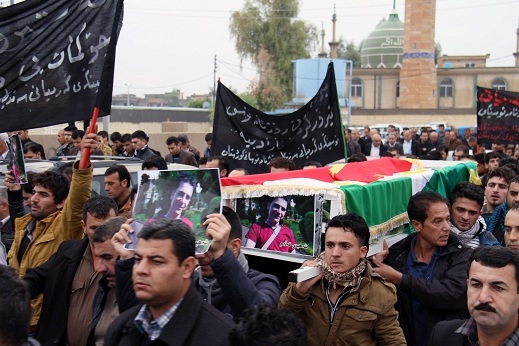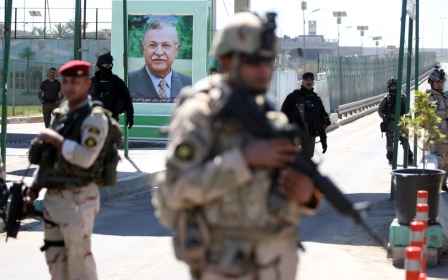Iraqi Kurdistan journalists struggle against climate of impunity

A few years ago Kawa Garmyane was busy making a name for himself. As editor of Kurdish magazine Rayel, Garmyane took aim at government and business interests and published a few articles condemning corruption in the semi-autonomous region in northern Iraq.
Iraqi Kurdistan is widely regarded as a relatively liberal and safe enclave in a country otherwise marred by violence and strife but in July 2012 some believe Garmyan went too far.
“You son of a dog, if you publish that magazine tomorrow, I’ll entomb your head in your dog father’s grave,” a voice barked down the phone at him in recordings later released on YouTube.
The man behind the threats was allegedly Mahmoud Sangawi, an army general and member of the ruling Patriotic Union of Kurdistan (PUK) party. Eighteen months later Garmyane was shot dead outside his home.
The finger was quickly pointed at Sangawi who was briefly arrested in January this year, although he was soon released for lack of evidence. A rank and file PUK member was instead charged with the killing, which has continued to send reverberations through Kurdistan's budding media community.
Speculation over who really killed the 32-year-old remain rife, but many in Kurdistan concede that the incident illustrates a continuing air of impunity and a widespread inability to enforce modern journalistic standards and freedoms.
International calls to stop impunity
According to a Committee to Protect Journalists (CPJ) report published this week, many journalists in Kurdistan say they fear “impunity for anti-press attacks, including murder and arson and feel they “must self-censor on topics like religion, social inequality, and corruption associated with powerful officials.”
Report author Namo Abdulla told Middle East Eye that “in Kurdistan, if you are a high-ranking official for one of the ruling parties or just hold some sort of strong tie to the ruling elite, you can absolutely be above the law and get away with doing almost anything you want.”
“You can kill a journalist. You can burn down a television station in the heart of the city. The court will still have difficulties to find enough proof to put you behind bars,” he added.
The Kurdish Journalist Rights Organization (Metro Center), which details abuses, says that there were 193 violations against Kurdish journalists last year. This is a significant drop from 2011, a particularly turbulent year, when 359 violations were reported, but a slight increase from 2012 when 132 instances were detailed.
Abuses take many forms. In 2011 a TV station NRT, which showcased reporting on the Arab Spring, was torched by armed men. Although there were no injuries, no one has thus far been brought to justice. Violations against individual journalists are also rife, and range from physical attacks and threats, such as beatings and stabbings, to legal proceedings that see journalists imprisoned and fined.
Metro Centre director Awat Ali told the CPJ that hundreds of lawsuits are filed against journalists every year, accusing them of defamation, espionage, disrespecting religion and “deviation from social norms.”
In principle, the law offers a range or protections. A 2007 press law specifically prohibits the imprisonment, harassment, physical abuse of reporters, or the closing down of publications.
The government has also pledged to step up reforms and Kurdish regional president Massoud Barzani just this week praised media freedoms and vowed to step up protections.
“Having a wide variety of newspapers, news channels and other types of media is delightful, as they have a great role in the awakening of the citizens and protecting our high national interests. It is our duty to protect such a civilized phenomenon in our country,” Barzani told reporters on Tuesday.
In practice though many complain that the law has little bearing on the situation on the ground.
According to the CPJ this discrepancy is clearly illustrated by the different treatment awarded international and domestic journalists.
“The situation here is safe for foreign journalists,” Sofia Barbarani, an Italian journalist who specialises in the Kurdish region, told MEE.
“I've always been aware that Kurdish security keeps a close eye on most journalists but have never felt pressurised or threatened. I have been told by local journalists to be careful regarding a story I am currently working on, but apart from that there have been no problems.
“But it is very different for local journalists. They usually know more and are more restricted and face greater danger,” she added.
The problem, however, may not be the lack of protections per say but rather the very nature of the system.
Noreldin Waisy, an independent Kurdish journalist and media advisor, previously best-known for founding the major Kurdish media network Rudaw, instead insists that it is a lack of education and training that inhibits the development of Kurdistan’s media that is already inherently held back by the region’s nepotistic and politicised system.
“Every party in Kurdistan has its own publications - newspapers, radio and TV,” Waisy told MEE.
According to Waisy, most people know which media outlet belongs to which party and know what to expect. On a deeper level many even know which particular politician is behind a certain publication.
“Beyond that there is a second layer,” Waisy adds. "The so-called private media which is mostly based in Sulaimania, is not independent at all but part of what is known here as shadow media".“These are [media organisations] that are not directly linked but are still funded by political parties.”
The problem, Waisy believes, is the economic unviability of Kurdistan’s media that has relatively small circulations and nascent advertising strategies which leave it almost totally reliant on political party hand-outs to stay afloat. The political support in turn, means that many so-called journalists are not really journalists at all but more akin to “glorified civil servants.”
“There are five million people in Kurdistan but we have maybe 5,000 journalists,” says Waisy. “Everyone presents themselves as a journalist. They all have press cards… But they are not journalists. They can be drivers, or policemen … but they have no academic background or training in journalism.”
People claim to be reporters in order to receive better salaries or other benefits that are often handed out by the political parties and it’s this that Waisy blames for the self-censorship and bias seen in Kurdistans’ media, rather than an outright air of fear and repression.
In 2013, Reporters Without Borders upgraded Iraq’s press freedom rating to 150th globally out of 179 countries. While not specifically stated in the report, Kurdistan is widely understood to harbour a more hospitable media climate. Neighbouring Turkey, however, fared worse, being ranked 154th by the press monitoring association. This year, it could slide further still after a spate of recent attacks on social media platforms, which have not been mirrored across the border in Kurdistan.
The CPJ singles out these new online communication tools as a bright spot to watch. It notes that Facebook and Twitter are popular and that good internet connection in the region may help these avenues to grow. But Waisy remains doubtful.
“Until we see a big improvement in education, change will be slow,” he says.
- Simona Sikimic is a News Editor at the Middle East Eye. She recently completed her MA in Political Journalism at Columbia University where she focused on human rights, development and Israel / Palestine. Prior to that she worked as a reporter at Lebanon’s The Daily Star and as a journalist in Syria. Her freelance work has appeared in The Guardian’s Comment is Free, The Majalla, and anti-corruption website 100 Reporters, among others. She has also been a citizen journalism and startup advocate.
Middle East Eye propose une couverture et une analyse indépendantes et incomparables du Moyen-Orient, de l’Afrique du Nord et d’autres régions du monde. Pour en savoir plus sur la reprise de ce contenu et les frais qui s’appliquent, veuillez remplir ce formulaire [en anglais]. Pour en savoir plus sur MEE, cliquez ici [en anglais].


